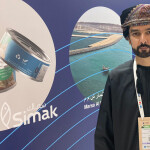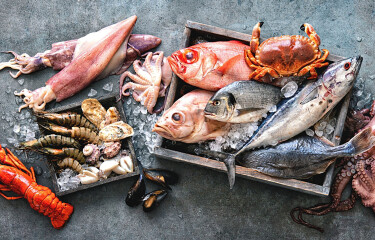Global seafood demand per capita will continue to grow through 2050, with production growing exponentially to meet that demand, according to the “Seafood Forecast” compiled by Norwegian risk management and assurance firm Det Norske Veritas (DNV).
The firm’s latest report analyzes the interactions between seafood value chains and other food systems, between food security and growing supply-demand imbalances across different regions, and between the need for sustainable feed and the need for a robust food supply. It forecasts an increase in overall marine seafood production – incorporating all farmed and wild-caught finfish, crustaceans, and mollusks – of about 20 percent by 2050.
Specifically, the Norwegian firm expects annual seafood production to reach 160 million metric tons (MT) by the midpoint of this century, with the fisheries sector producing 101 million MT when including illegal, unreported, and unregulated (IUU) fishing output and a marine animal aquaculture sector that nearly doubles its production to 59 million MT.
DNV also projects that in 2050, when the world’s population is expected to eclipse 9 billion people, seafood demand per capita will be highest in Southeast Asia, and marine and freshwater seafood will account for more than 30 percent of total protein consumption.
Despite rising consumer demand for seafood, DNV doesn’t believe there will be any significant changes in protein consumption patterns or large-scale dietary shifts to the category from other food groups.
DNV’s Group Research and Development Program Director of Ocean Space Bente Pretlove told SeafoodSource the analysis points to total protein demand climbing 33 percent through 2050, with meat demand increasing 30 percent.
“Hence, there is little reason to conclude that there will be a general dietary shift toward seafood globally,” she said. “There are large regional differences; for instance, in Europe, meat consumption will go down, whereas fish consumption will go up. In Latin America, meat consumption [is expected to go] up much more than fish consumption.”
Pretlove said that there will be difficulties scaling up land-based food production to meet global demand, with climate change being the leading obstacle. She said a future consumer shift toward a more seafood-based diet could relieve some of this pressure, but added that large shifts like these are slow-moving processes influenced by affordability, food culture, and other consumer preferences.
Nevertheless, given a sufficient change in demand, expanding marine aquaculture represents a significant worldwide opportunity, and DNV predicts stagnant output in capture fisheries but doubled aquaculture production and tripled finfish production in this period to 23.2 million MT annually, which would see the category overtake mollusks as the single biggest species group produced when measured in live weight.
“This means that species types with higher edible yields win out (e.g., you can eat a larger percentage of a fish than of an oyster). But, finfish need feed, which puts additional pressure on land-based agriculture,” Pretlove said.
She expects the “main winners” among aquaculture species are likely to be high-value species like salmon and shrimp.
While DNV doesn’t model exact outlooks for specific species, its report slated 12 percent of finfish aquaculture to come from onshore facilities using recirculating aquaculture systems (RAS) and similar new technologies by 2050 and another 7 percent to come from offshore structures in the open ocean.
At the same time, it suggests crustacean farming will double, reaching 13 million MT annually, and mollusk farming will grow 25 percent to 17.5 million MT.
To meet future growth, the sector must ...
Photo courtesy of Alexander Raths/Shutterstock








